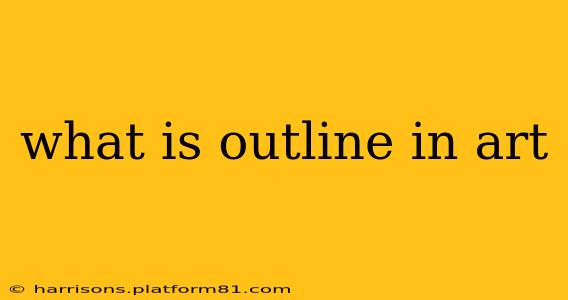The outline, a seemingly simple element, plays a crucial role in art, impacting composition, form, and overall aesthetic appeal. It's more than just a line around a shape; it's a powerful tool used by artists across various mediums and styles to define, shape, and communicate ideas. This guide delves into the intricacies of outlining in art, exploring its purpose, techniques, and impact.
What is the purpose of an outline in art?
The primary purpose of an outline in art is to define the edges and boundaries of a form or shape. It establishes the silhouette, giving the viewer a clear understanding of the subject's basic structure. However, its function extends far beyond this basic definition. Outlines can:
- Separate figures from their background: Creating visual distinction and preventing elements from blending together.
- Convey movement and energy: Bold, dynamic outlines can suggest action and dynamism, while softer lines might evoke stillness or tranquility.
- Establish mood and tone: The weight, style, and color of an outline can dramatically shift the overall feeling of a piece. A heavy, dark outline can feel dramatic or harsh, while a light, sketchy outline may convey fragility or delicacy.
- Guide the viewer's eye: Outlines can subtly direct attention to specific areas within a composition, leading the viewer's gaze through the artwork.
- Add texture and detail: Varying line weight and style can create visual texture and enhance the illusion of depth and form.
What are different types of outlines in art?
The world of outlining extends far beyond a simple, single line. Artists utilize a variety of techniques and styles to create different effects:
- Solid outlines: Thick, consistent lines that clearly define the shape. These are often used in graphic design, children's illustrations, and some forms of printmaking.
- Broken outlines: Lines that are interrupted or fragmented, creating a sense of movement or imperfection. This style is often seen in sketches and looser artwork.
- Implied outlines: Where the shape is suggested by changes in color, value, or texture, rather than a distinct line. This creates a more subtle and atmospheric effect.
- Varied line weight outlines: Utilizing thicker and thinner lines to create depth, volume, and emphasis on certain areas of the artwork. This technique is particularly effective in suggesting form and three-dimensionality.
- Contour lines: Lines that follow the curves and contours of a form, emphasizing its three-dimensionality.
How do different mediums influence outlining?
The medium used significantly impacts how outlines are created and their appearance.
- Painting: Outlines can be achieved through bold brushstrokes, careful application of paint, or by creating a line of contrasting color.
- Drawing: Various tools like pencils, charcoal, pens, and inks offer a range of line weights and textures, enabling different outlining styles.
- Printmaking: Techniques like linocut or woodcut rely on carving lines into a surface to create a distinct outline.
- Digital art: Digital tools offer immense flexibility, allowing for precision and control over line weight, style, and color.
Does outline in art always have to be a visible line?
No, outlines don't always need to be explicitly visible. As mentioned earlier, implied outlines use variations in color, tone, or texture to define a shape without relying on a distinct line. This technique creates a more subtle and less rigid aesthetic.
What are the advantages and disadvantages of using outlines in art?
Advantages:
- Clarity and definition: Provides clear separation and structure.
- Emphasis and focus: Directs the viewer's eye.
- Versatility: Can be adapted to various styles and mediums.
Disadvantages:
- Can feel stiff or rigid: Overuse of solid outlines can make artwork feel two-dimensional.
- Can detract from other elements: Dominating outlines might overshadow other details.
- Limitations in certain styles: May not be suitable for all artistic approaches, such as Impressionism.
Conclusion
The outline, a fundamental element in art, holds immense power and versatility. Understanding its purpose, techniques, and impact allows artists to harness its potential to create compelling and engaging artwork. From defining forms to creating mood and guiding the viewer's eye, the outline continues to be a vital tool in the artist's repertoire.
